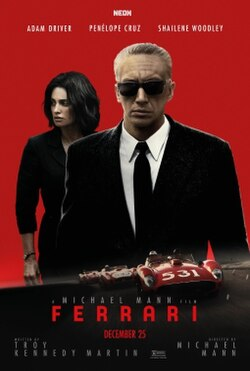Ferrari

Movie Info:
🧠 Overview of the story
Ferrari (2023), directed by Michael Mann, is a biographical picture that revolves around the life of Enzo Ferrari, the car manufacturer, and the founder of the Italian car brand. Rather than a life story, the movie focuses on a critical moment on the year 1957, which shaped Enzo’s life. This is the year when his business was struggling and also when his family life was falling apart
Ferrari, like any other business after world war 2, had the sword of damocles suspended over his head. His concer te company was almost bankrupt due to the inability to meet mass production like other car manufacturers were doing. The company’s survival relied on a daredevil wounded- animal strategy of triumphing the Mille Miglia ( a hundred-mile open-road endurance race throughout Italy). Winning this car race could get them the much-needed funds to save the company.
At the same time, Enzo’s personal life also seems to be crumbling. He is mourning the loss of his son, Dino, who passed away the previous year from muscular dystrophy. He is also dealing with two women who seem to be at the center of his life drama. Laura (Penélope Cruz), his fiery wife who has not moved on from their marriage and is part owner of the company, and Lina Lardi (Shailene Woodley) is the mother of his son, Piero. Enzo is battling with the conflict of enduring passions and grief, legacy, and duty which risk quite literally everything he has built on.
With the inclusion of contestants such as Alfonso de Portago and Piero Taruffi, as well as the drivers and engineers that Ferrari has premade, the building pressure that accompanies the a set race vise Mille Miglia is almost palpable. The climactic race serves an existential purpose and is almost indispensable not only to Ferrari as an individual but to his humanity. Enzo loses out on his ambition in horror as de Portago and countless others, including children, meet their end.
The sombre note serves as a reminder to the demand defiance Ferrari expresses. Despite experiencing loss and drama, Ferrari is persisting which exemplifies the legacy he will now be defined and known for.
🎭 Characters and Performances
Enzo Ferrari (Adam Driver)
Adam Driver’s performance is quietly intense, depicting Enzo as haunted, obsessive, and stoic. Driver effectively brings out Ferrari’s complex duality of being composed on the outside and privately beside himself with torment, adding internal fire without being too bombastic.
Laura Ferrari (Penélope Cruz)
Penélope Cruz is compelling as Enzo’s estranged wife. Her performance is a blend of great emotion as she displays a mixture of sorrow, fury, and grace. Laura is the moral backbone of the film, the sole character who can confront Enzo’s hubris and reveal his weakness.
Lina Lardi (Shailene Woodley)
Shailene Woodley embodies a maternal and serene side of Ferrari’s character as Lardi. Although she does not share as much screen time as Cruz, she brings depth to the film as gentle, calm, and nurturing, balancing Laura’s tempestuousness.
Alfonso de Portago (Gabriel Leone)
As the young, charismatic driver played by Gabriel Leone, Portago embodies both the hopes and peril of Ferrari’s vision. His tragic fate in the Mille Miglia race serves as the film’s emotional turning point.
🎥 Themes and Symbolism
Grief and Legacy
The Ferrari film focuses on Grieving a lost family and ideals. Enzo’s Grieving over Dino is the shaping force of his decisions and relationships. As the processes goes, a car depicts a metaphor to represent control in his life that is slowly slipping away.
Obsession and Sacrifice
The film portrays Enzo Ferrari as a man obsessed with his vision. In pursuit of his goals, the film poses the following question: what is the true cost of pursuing greatness? Everything—even marriages, children, and lives—seems to be at risk of his relentless ambition.
Speed and Mortality
The Mille Migilia race is more than just a showpiece event, and Mann uses it to showcase the elegant yet risky balance between glory and tragedy. This quotation reminds us of the breathtaking and brutal aspects of racing of speed.
Women and Emotional Truth
The film shifts to a more emotional lens to balance its hyper masculine narrative through Laura and Lina. These two women do not serve as passive characters, as they actively seek to bring enzo to expose the dehumanizing cost that his empire creates.
🎞️ Cinematic Style and Atmosphere
As with his other movies, Mann applies and maintains a heated and emotionally cold yet visually sharp of Enzo Ferrari. In vibrant saturated Italy of the 1950s, the cinematography of Erik Messerschmidt exhibits warmth and sharp grittiness. Viewers of post-war Europe are aided with the period race cars, clothing, and the kostyms.
The thrilling and visceral race sequences are individually filmed with a unique blend of kinetic realism and operatic splendor. The audience seems to be placed in the cockpit due to the engine’s roar and the screeching tires dominating the soundscape. The Mille Miglia is also filmed with nerve-wracking intensity and culminates in a catastrophic crash that is depicted with stark realism.
The score by Daniel Pemberton could be described as classical and brooding which underscores the emotion of the film while staying in the background of the drama.
⭐ Reception and Interpretation
Critical Response
Ferrari’s performance and visual craftsmanship received the most praise while the film as a whole received positive reviews. Critic’s appreciated Mann’s focused direction and Driver’s nuanced performance of Enzo. While critics noticed the narrative to be emotionally cold or too narrow, others appreciated the character-driven approach praising the narrative’s restraint.
Audience Reaction
For fans of biographical film and car enthusiasts, Ferrari is more emotionally textured as a biopic rather than a racing film. It’s reception by the audience is that it is able to humanize a celebrated figure and not glorify his flaws. The racing scenes, while few in number, were deemed to be realistic and intense.
📽️ Key Takeaways for Viewers
Expect introspection over action as the film is presented as a character study, not as a mere celebration of Ferrari’s engineering marvels.
It captures a depiction of astonishing brilliance intertwined with profound emotional ruin.
The movie focuses on the cost to the man’s life on the legacy he leaves behind, not the racing victories.
Verdict
“Ferrari (2023)” is a carefully crafted, self-reflective character analysis that avoids the cliches of traditional biopics. Michael Mann’s masterful direction and Adam Driver’s reserved performance portrays the tempestuous soul of a man marked by his need for speed, success, and the sorrow that followed. Stylish and somber, this film offers a thoughtful peek beneath the legend’s hood, revealing the human cost of his muscle-bound legend.








